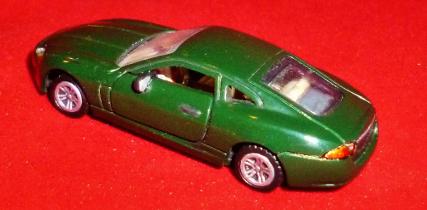
2007 Jaguar XK
Jaguar, from its earliest days as “Swallow Sidecars”, has created many great, and stylish, sports cars. The leaping cat has also seen great triumphs and depression ridden eras too. The new XK range launched in 1996 embodied everything the company stood for with a sleek three-door hatchback coupé and a refined convertible. The original car was drawn out by Jaguar design director Geoff Lawson as a two-door 2+2 grand tourer and debuted in March 1996 at the Geneva Motor Show.
The first generation were marketed as the XK8 (X100), introducing a new 32-valve, 4.0-ltr, V8 engine; the first V8 car in the range since the Daimler 250 V8 which went out of production in 1969. The series had all that you would expect from a Jaguar, a powerful 370hp motor, leather interior and burl walnut trim (to mention a few) coupled to the latest modern must haves and safety features like 17-inch alloy wheels and side airbags. If you wanted to pay a bit more 18-inch, 19-inch, or 20-inch wheels and Adaptive Cruise Control featured amongst the optional extras. From 1998 a more powerful 375hp engine was available in the XKR, a sportier supercharged version of the XK8 with a mesh grill and bonnet louvres to improve airflow through the engine.
A further uprated car came in 2002 with both cars now having an enlarged 4.2ltr motor and new ZF 6HP26 6-speed automatic gearbox. The range was also given additional exterior colours, new wheel styles, a new grill and enlarged front and rear aero’ packages. Although by now the technological side of the car was being superseded the XK8 remained saleable, not least because it was a truly attractive, sensuous, body shape.
In 2005 Jaguar had a replacement car on the way. The Ford Motor Company, parent company to Jaguar, had invested a lot of cash to get Jaguar back to its place amongst the great European sports/luxury marques and while the XK8 had styling that just kept on looking great the small cabin and luggage space, efficiency and handling were far from class-leading.
The new XK (X150) was elegant and the coupé had clear familial links back to the timeless E-Type. Far from a development of the XK8 the X150 series XK replacement was a very different vehicle. After Geoff Lawson had passed away in 1999 Ian Callum took up the baton of Jaguar design director and subtly shifted the design philosophy approach of the Jaguar range, the new XK was no exception. Callum explained his design thinking by saying :-
“The fundamental values of Jaguar design do not change. We took influences from our heritage and evolved them to produce a car that is beautiful, visually fast yet undeniably modern – just as (Jaguar founder) Sir William Lyon's own designs were in their day”. The new looks he described as “clean lines, a purposeful stance and exquisite proportions”.
The grille harks right back to the 1961 E-Type with its oval opening, horizontal bar and central badge, despite some people thinking this was a Ford que after the 1995 Ford Taurus (designed by Moray Callum, Ian’s brother) had a similar bar and Ford Logo set into an oval opening.
The Prototype Jaguar “Advanced Lightweight Coupé” made a surprise appearance at the January 2005 Detroit auto show. Although not put forward as a replacement for the XK8 at the time, it was clearly more than a concept car. By the time it flew up the hill at the Goodwood Festival of Speed in June 2005 the car was pretty much the done deal, Mike Cross (Jaguars chief engineer for vehicle integrity, responsible for sorting Jaguars handling), doing the driving himself. When the Jaguar XK hit the stands at the September 2005 Frankfurt Motor Show in Germany the final production model was there for all the world to see. Sales would start in April 2006 for Europe and spring 2007 in North America.
While some described the 2006 XK as looking like an XK8 that been to the gym, the truth was this was no evolution of the previous car but significantly different car. On the outside it may have had similarly gracefully sloping lines and still exhibit the renowned Jaguar craftsmanship and quality but now it had cutting edge technology in design, construction and onboard computational aids. Mike Cross (Jaguar's Chief Engineer), explained :- “The XK may be the epitome of sporting elegance but it is also a true driver's car in which we have managed to combine a very special balance of superb driving dynamics and comfort.” Compared to the steel-bodied XK8 the new XK accelerated faster and stopped more quickly, it weighed less and was much more agile too. Some of this stability is attributed to the XKs wheelbase having been increased by six inches despite the car only being about half an inch longer than the XK8 had been, thus less overhang front and rear. Equally the new model is just about 2.4 inches wider and 4.7 inches taller. As for the styling the Scottish-born designer said, "The dimensions are set by regulations," the front in particular because European rules dictate the design of a cars nose in order to reduce injuries to pedestrians. For the XK this means a higher bonnet line and lower air dam than Mr. Callum would have liked. He still created a gorgeous car though, so much so that the companies 2005/6 ad’ campaign was actually built around the word “Gorgeous”, subliminally trying to link the gorgeous people in the films with the gorgeous lines of the car.
However, this car was so much more than a pretty face, under the skin it was radically different, and this was the key to its exhilarating performance. Firstly, its industry-leading construction was entirely of aluminium; sheets, extrusions and castings being bonded with high-strength aerospace adhesives and riveted together to form an aluminium monocoque coupé structure that was the stiffest in its Class. Although the use of castings might have been a little more expensive, in construction terms, than the sheet metal stamping panel reinforcements of the XJ, the XK is a much more limited run vehicle and casting actually turns out to require less tooling up costs. All this aerospace technology made the XK the most technically advanced Jaguar production car ever built and gave it a chassis that was significantly lighter, and stronger, than competitors from BMW and Mercedes-Benz. The use of the riveting and bonding method had been used on the production XJ sedan but was a first for a Jaguar Grand Tourer; the result of this being improved handling and fuel economy for the XK.
Production was run at Jaguar's state-of-the-art facility, at Castle Bromwich in the West Midlands, were the coupé and the convertible could be built parallel to the XJ. Production at the historic Browns lane, Coventry plant had ceased sometime before. Today almost all connections with Browns lane are lost with all Jaguar production work having moved to other locations by 2007.
At this point we will mention the respective weights of the XK8 and the XK. Firstly, the coupé’s weight dropped by a huge 70kg over the previous model. Now the surprise, the Convertible, traditionally heavier cars due the additional strengthening required when the roof is removed from the equation, lost 100kg! Both cars now being lighter than a comparable BMW645i or M-B SL500. One reason for the convertibles weight loss was in the way the roof was constructed. Jaguar decided against a rigid roof using instead a semi-rigid fabric top, allowing not only lighter motors to be used to retract the hood but also taking less space up in the trunk area too.
The reason for mentioning the weight now is to highlight just how important the lightweight body was. Jaguar claimed the XK had a power-to-weight ratio 10% better than the Mercedes-Benz SL500's which allowed the car to accelerate from 0 to 60mph "comfortably below" 6sec’s and could do a quarter-mile within 0.2 second of the previous high output XKR's time.
The power side of the ratio was provided by a 4,196ltr, AJ-series V8 engine; essentially an up-rated version of the 4ltr motor from the XK8. Jaguar’s 4.2ltr unit was now turning out around 390hp thanks to some clever work with the electronic fuel injection. For those worried about the ecological arguments the XK had a Catalytic Converter to clean out the waste gases before anything harmful got to the atmosphere. The powerful engine was mated to a six-speed automatic transmission built by ZF so the standard XK had a top speed 158mph, or 254 kph if you prefer, which is way above the legal speed limits in most countries.
Putting the power on the road was handled by a Computer Active Technology Suspension (CATS) controlling pitch & yaw of the unequal-length double wishbone independent suspension, with coil springs & Bilstein shock absorbers all round, on all four corners. This system is made all the better by the stiffer body which allows the suspension to be more precisely tuned for performance and gets a better response from the driver aids like traction and stability controls, brake force distribution and the antilock brake system. Jaguar say: “The base XK’s all-wheel independent is actually almost as stiff as the last-generation XKR’s, yet [its] ride is not at all compromised.”
When it comes to steering once again the speed-sensitive rack-and-pinion steering is more effectively tuned because of the stiffer body. While Jaguar claim the steering is the “most precise and direct in the class, with exceptional feedback to the driver,” driver feedback has been mixed. Some drivers felt the steering was too heavy while others described a lack of feeling even calling the steering numb. This is probably more of a subjective personal thing depending on driver preferences. Most importantly the XK steering is precise and the turning circle was just 33.3ft.
So, the XK looks fantastic on the outside, the handling is livelier, power is up, weight is down economy is improved. But what about the interior and practical side of the car.
Those who felt the XK8 was a bit cramped on the inside had their way with the new XK. Its classic 2+2 seating format now had more legroom, more width and more head room, without making the car look out of proportion on the outside. 20mm more headroom and 35.5mm more shoulder room made the XK interior much airier, and, the increased front leg room was very noticeable as the driver and passenger no longer had their legs wedged against the transmission tunnel or in the way of the steering wheel, sadly the rear passengers still needed to be under the age of seven to fit in the space allocated for rear seats. The XK convertible also saved general space by having roll-bars that pop up in the event the car should rollover.
More space was also made available in the boot, something very necessary in a Grand Tourer, almost 50% more space. Jaguar made run-flat tires an optional extra thus the need for a spare was eliminated giving more luggage space.
Looking at the styling of the interior contoured, electrically adjustable, heated leather front seats hugged the body and the steering column mounted gear shift paddles gave a clue to the highly sophisticated electrical packages now available to the driver, there wasn’t even a need to put a key on a slot to start the car, just having the remote key fob in the car was enough to allow the starter button to bring the engine to life. A touch screen controls the Jaguar’s Driver Information Centre system and a round selector knob allows choice of the drive system. The luxury car goodies on XK included central locking, electric windows, air conditioning, climate control, power-assisted steering, tiltable steering wheel, cruise control, parking sensors, a navigation system and an in-car audio system with the usual radio system, CD player and CD multichanger. There was even a wireless Bluetooth communication system allowing in-car phone calls and even a “do not disturb” mode that stops incoming calls.
One bizarre item related to the interior of the XK is the so called “bark tube”. The design team had done such a good job of noise cancellation that some drivers found the cabin too calm and peaceful. Sports car drivers tend to like the sound of the exhaust growling away and Jaguar had inadvertently taken away some of the driver experience when they insulated the cabin. To reintroduce the auditory experience Jaguar not only adjusted the exhaust system to have valves that open at certain RPM to make the exhaust louder they also ran a tube (a sort of long resonance chamber) from the XK’s intake manifold, through the bulkhead, into the space behind the radio controls. This tube then had a 25mm diaphragm at the end effectively turning it into speaker that, under specific engine load conditions, produced the right sort of throaty roar to please the sports car sound enthusiasts.
All the ‘de rigueur’ safety aids are of course included, front and side airbags, anti-lock brakes, an electronic stability program and traction control. The most technically innovative safety feature was a very clever part of the pedestrian protection system. If the front bumper mounted sensors detect a pedestrian impact, they fire off two pyrotechnic charges that instantly lift the bonnet to create extra distance between the engine and the bonnet making the bonnet a sort of external airbag; it’s still metal, but, a much more deformable structure than the solid block of the engine which usually lurks just a small distance beneath the bonnet which is the main cause of serious injury in pedestrian impacts.
While the 2006 XK was a big improvement in all ways over the XK8, Jaguar never rest on their laurels. In August 2006 the XKR went on sale followed by even higher spec’ versions from March 2007, we’re talking supercharged engines that pushed out 400-420hp with even more powerful engines to come. In 2009 the 4.2ltr engine was swapped out for a 5ltr naturally aspirated unit on the standard XK, more powerful and more efficient, one can only wonder at the exhilaration of driving such a car. For those lucky enough to be able to afford Jaguars creations then the 2011 Geneva Motor Show provided a serious temptation, the XKR-S. 0-60mph in 4.4sec’s and a top speed of 186mph, that’s 300kph for those who use the European system. If it could be let loose the engine has more to give but Jaguar has the ECU govern the engine to that maximum speed for aero’ stability. New front and rear aero’ packages keep the car on the road and together with other new styling points gave the XKR-S a more function over form appearance, still gorgeous, but now more assertive. An XKR-S convertible was introduced later in 2012.
In 2013 the final versions of the XK series were produced. They had modifications to the suspension and steering, and, the XKR-S Vulcan alloy wheels were made available to the XK. The ultimate XK version was the 542bhp XKR-S GT. This was the fastest Jaguar production car to date with race inspired modifications that allowed the XKR-S GT to go from 0-60mph in under 4sec’s and turn a lap of the Nürburgring Nordschleife in less than 7m40s. Wider wheel arches hinted at the wider track but much more was going on with the suspension. Camber was increased and bushings revised, stiffer spring rates all-round with adjustable ride height dampers by Eibach gave further improved road holding while the faster ratio steering rack, borrowed from the new F-type, and 20in forged alloy wheels with carbon-ceramic brakes gave grip, feel and stopping power. The XKR-S GT was phenomenal in performance and had a truly aggressive race bread looking carbon-fibre body kit.
Like the XK120, XK-SS, XKE and XJ-220 before it the XK series had been a brilliant package with many devotees. But, having reached the end of its development life the XK series went out of production in July 2014. The F-Type Jag’ was based on the XK but there was no actual replacement model for XK. The XK series remains popular on the ‘previously enjoyed’ market, a testament to the quality, endurance and style that the name “Jaguar” evokes.












Ian bought two of the items from our friends at Form-U-Lay and was impressed with how much detail the company had squeezed into such a small scale. He had been on the lookout for contemporary cars to build and use in illustrative 00-H0 scale dioramas showing how the garage/service/sales industries had changed over the years. Only the Jaguar kit #13 and the Honda Odyssey, kit #14, really fitted the bill the others being high end supercars unlikely to be generally encountered on the normal roads.
The model can be pushed together by eager fingers in a short amount of time. For the more discerning model maker, who likes everything to be tidy and correct, it is still only about ¾ of an hour to get the parts all cleaned and put together. However, if you are prepared to put a few more hours of painting into the model then its full potential can be realised.
Ian cleaned up all the parts and did a push fit test build. Happy with the parts he then took it apart again to prime and paint all the parts. AlcladII white primer was used to prepare the plastic before it was painted with Zero TWR Jaguar green mixed with a little Zero Matt black. Zero gloss top coat then gave the final finish. Interior and detail painting was done by brush using Deco-Art acrylic paints, accented with Tamiya, Revell and Citadel paints and ink washes.
This might be a simple kit but under the right circumstances can be a very nice model and sell a scene on a railway layout or small diorama very effectively.

